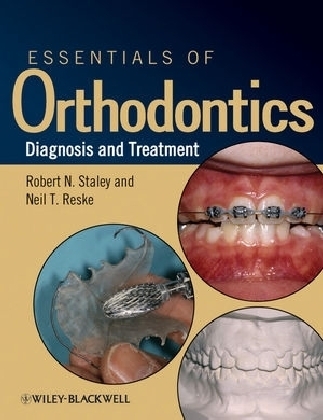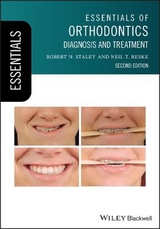
Essentials of Orthodontics
Iowa State University Press (Verlag)
978-0-8138-0868-0 (ISBN)
- Titel z.Zt. nicht lieferbar
- Versandkostenfrei
- Auch auf Rechnung
- Artikel merken
Robert N. Staley, D.D.S., M.A., M.S., is a professor in the Orthodontic Department at the University of Iowa College of Dentistry, where he has been on faculty since 1970. He is a diplomate of the American Board of Orthodontics, and among his many awards he received the Student Research Group Mentor of the Year Award for 2003-2004. Dr. Staley has served as an editorial consultant for various peer-reviewed journals and sits on the editorial board for The Angle Orthodontist. Neil T. Reske, M.A., also from the University of Iowa College of Dentistry, teaches dental students, orthodontic residents, and pediatric dentistry residents the principles and techniques of laboratory appliance fabrication.
Preface. Acknowledgements. Introduction. Chapter 1. Orthodontic Diagnosis and Treatment Planning. Normal and Ideal Occlusion. Normal Occlusion in the Primary Dentition. Angle Classification of Malocclusion. Angle Class I Malocclusion. Class I Malocclusions in the Primary and Mixed Dentitions. Angle Class II Division 1 Malocclusion. Angle Class II Division 2 Malocclusion. Class II Malocclusions in the Primary and Mixed Dentitions. End-to-End Occlusions. Angle Class III Malocclusion. Class III Malocclusions in Primary and Mixed Dentitions. Super Class I Malocclusion. Super Class II and Super Class III Malocclusions. Subdivision Malocclusions. Class II Subdivision Malocclusions. Class III Subdivision Malocclusions. Class II-III Subdivision Malocclusion. Incisor Compensations in Class II and Class III Malocclusions. Iowa Notation System for Angle Classification. Rules for Assigning Angle Classification. Rating the Severity of a Malocclusion. Orthodontic Records. Clinical Examination. Summary of Findings, Problem List, and Diagnosis. Consultation with Patient and/or Parent. Chapter 2. Dental Impressions and Study Cast Trimming. Study Casts. Digital Casts. Alginate Impressions. Mandibular Impression. Record of Centric Occlusion. Pouring of Plaster Study Casts. Study Cast Trimming. Chapter 3. Dental Cast Analysis in Adults. Tooth Size-Arch Length Analysis. The Measurement of Tooth Size and Arch Length. Factors Influencing a Tooth Size-Arch Length Analysis. Curve of Spee. Incisor Inclination and Anteroposterior Position. Second and Third Molar Evaluation. Comparison of TSALD and the Irregularity Index. Arch Width Measurements. Diagnostic Setup. Bolton Analysis. Overbite and Overjet Measurements. Mandibular Crowding. Tooth Widths in Normal Occlusion. Chapter 4. Dental Cast Analysis in the Mixed Dentition. Tooth Size-Arch Length Analysis. Prediction of the Widths of Nonerupted Canines and Premolars. Revised Hixon-Oldfather Prediction Method. Iowa Prediction Method for Both Arches. Standard Error of Estimate. Radiograph Image Problems. Proportional Equation Prediction Method. Tanaka and Johnston Prediction Method. Measurement of Arch Lengths on Casts. Measurement Instruments and Guidelines. Factors that Influence a Mixed-Dentition Arch Length Analysis. Interpretation of a Mixed-Dentition Arch Length Analysis. Chapter 5. Radiographic Analysis. Periapical Survey. Panoramic Radiograph. Occlusal Radiographs. Cone Beam Radiographs. Lateral Cephalometric Radiographs. Anatomic Landmarks. Cephalometric Landmarks. Cephalometric Point Locations. Cephalometric Angles and Distances. Cephalometric Norms and Treatment Goals. Lateral Cephalometric Tracing. Posteroanterior Cephalometric Radiograph. Analog versus Digital Radiography. Chapter 6. Lingual and Palatal Arches. Incisor Liability and Leeway Space. Passive Lower Lingual Holding Arch. Prevalence of Incisor Crowding. Premature Loss of a Primary Molar. Asymmetric Loss of a Primary Canine. Nance Holding Arch. Trans-palatal Arch. Insertion of a Passive Lingual or Palatal Arch. Fixed-Removable Lingual and Palatal Arches. Undesirable Side Effects of Passive and Active Lingual and Palatal Arches. Laboratory Prescription and Construction of a Lower Loop Lingual Arch. Chapter 7. Management of Anterior Crossbites. Prevalence of Anterior Crossbite Malocclusions. Angle Classification. Centric Relation to Centric Occlusion Functional Shift on Closure. Overbite. Adequate Arch Length. Inclination of Maxillary Incisor Roots. Rotation of Tooth in Crossbite. Number of Teeth in Crossbite. Alignment of Lower Anterior Teeth. Treatment of Anterior Crossbites with Removable Appliances. Treatment of Anterior Crossbites with Fixed Appliances. Construction of a Removable Maxillary Appliance to Close a Diastema and Correct a Lateral Incisor in Crossbite. Chapter 8. Management of Posterior Crossbites. Definition of Posterior Crossbite. Prevalence of Posterior Crossbite Malocclusions. Angle Classification. Intermolar Width Measurements. Age of Patient. Buccolingual Inclination of the Posterior Teeth. Etiology of Bilateral and Unilateral Posterior Crossbites. Vertical Dimension. Treatment of Posterior Crossbites. Correction of Posterior Crossbites with Removable Appliances. Correction of Posterior Crossbites with Fixed Expander Appliances. Chapter 9. Management of Incisor Diastemas. Prevalence of Maxillary Diastemas. Etiologic Factors to Consider. Size of Teeth and Bolton Analysis. Arch Size. Maxillary Labial Frenum. Rotated Incisors. Thumb Sucking Habit. Angle Classification. Management with Appliances. Treatment of a Diastema with a Removable Loop Spring Appliance. Treatment of a Diastema with a Finger Spring Removable Appliance. Treatment of a Diastema with Fixed Appliances. Chapter 10. Molar Uprighting and Space Gaining. Introduction. Ectopic Eruption of Permanent First Molars. Uprighting Molars in the Mixed Dentition. Ectopic Eruption of Upper First Molars. Ectopic Eruption and Tipping of Lower First Molars. Mesial Tipping of Permanent Molars after Loss of a First Molar. Prevention of Molar Tipping after Loss of a First Molar. Impaction of Second Molars. Loss of Both First and Second Molars. T-Loop Uprighting Spring and Edgewise Fixed Appliance. Forces Generated by the T-Loop Uprighting Spring. Patient Treated with a T-Loop Uprighting Spring. Helical Uprighting Spring. Forces Generated by the Helical Uprighting Spring. Patient Treated with a Helical Uprighting Spring. Other Appliances Used to Upright Molars. Repositioning of Teeth Prior to Prosthetic Restoration. Chapter 11. Orthodontic Examination and Decision Making for the Family Dentist. Introduction. Orthodontic Screening. Guidelines for Decision Making. Differentiate Class I Problems Suitable for Limited Orthodontic Treatment from More Complex Class I Problems. Pretreatment Records. Patient 1. Patient 2. Patient 3. Patient 4. Patient 5. Patient 6. Patient 7. Patient 8. Patient 9. Treatment Records. Patient 1. Patient 2. Patient 3. Patient 4. Patient 5. Patient 6. Patient 7. Patient 8. Patient 9. Chapter 12. How Orthodontic Appliances Move Teeth. Introduction. Biomechanics. Newton's First Law. Newton's Second Law. The Keys to Understanding the Delivery of Orthodontic Forces. General Displacements of Rigid Bodies. The Limitations of Illustrating Three-Dimensional Tooth Movements in Two-Dimensional Figures. Translation of a Tooth in the Edgewise Fixed Appliance. How a Tooth Is Translated in the Edgewise Fixed Appliance. Rotation of a Tooth in the Edgewise Fixed Appliance. Newton's Third Law. Chapter 13. The Edgewise Fixed Appliance. Introduction. The Edgewise Appliance. Arch Wires. Bands. Separators. Fitting a Band. Cementing a Band. Band Cements. Removal of Bands. Bonding of Brackets. Anatomic Considerations. The Straight Wire Appliance. Bracket and Molar Tube Placement. Direct and Indirect Bonding. Removal of Brackets from Teeth. Arch Form. Chapter 14. Retention Appliances. Introduction. Invisible Retainers. Essex Retainers. Basic Retainer Design. Wire-Bending Skills. Maxillary Labial Bow Bending. Ball Clasp. C-Clasp. Adams Clasp. Resta Clasp. Mandibular Labial Bow. Acrylicing Retainers. Acrylic Finishing and Polishing. Chapter 15. Orthodontic Materials. Introduction. Orthodontic Wires. Stainless Steel Wires. Sensitization. Cold Working. Recovery Heat Treatment. Annealing. Cobalt-Chromium-Nickel Wires. Beta-Titanium Wires. Nickel-Titanium Wires. Physical Properties of Orthodontic Wires. Electric Welding. Flame Soldering. Electric Soldering. Index.
| Erscheint lt. Verlag | 8.2.2011 |
|---|---|
| Verlagsort | Arnes, AI |
| Sprache | englisch |
| Maße | 189 x 242 mm |
| Gewicht | 732 g |
| Themenwelt | Medizin / Pharmazie ► Zahnmedizin |
| ISBN-10 | 0-8138-0868-5 / 0813808685 |
| ISBN-13 | 978-0-8138-0868-0 / 9780813808680 |
| Zustand | Neuware |
| Haben Sie eine Frage zum Produkt? |
aus dem Bereich



